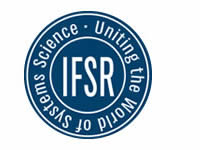Proceedings of the IFSR Conversation 2012, St. Magdalena, Linz, Austria
|
James Martin (USA), martinqzx@gmail.com (Team Leader) Johan Bendz (SE), johan@bendz.se Gerhard Chroust (AUT), Gerhard.Chroust@jku.at Duane Hybertson (USA), dhyberts@mitre.org Harold “Bud” Lawson (SE), bud@lawson.se Richard Martin (USA), richardm@tinwisle.com Hillary Sillitto (UK), hillary.sillitto@blueyonder.co.uk Janet Singer (USA), jsinger@soe.ucsc.edu Michael Singer (USA), mjsinger@soe.ucsc.edu Tatsumasa Takaku (JP), takakut@kamakuranet.ne.jp |
Abstract: We explored developing “common language for systems praxis” to help systems theorists and systems practitioners deal with the major cross-discipline, cross-domain problems facing human society in the 21st Century. For the first three days, we explored a broad range of issues, from previous efforts at standardization; to the nature of language, culture, and praxis; to the relationship between systems science, systems thinking, and systems approaches to practice. On day 4, we used Checkland’s CATWOE approach to understand the usage, context, and constraints for any common language for systems praxis. On day 5, this checklist helped us develop a diagram showing how an integrated approach to Systems Praxis could put theories from Systems Science and Systems Thinking into action through technical Systems Engineering and social Systems Intervention.
We learned that the best medium for communication across different ‘tribes’ is patterns, and that a common language for systems praxis could use system patterns and praxis patterns to relate core concepts, principles, and paradigms, allowing stakeholder ‘silos’ to more effectively work together. We captured this vision in a diagram that provided a neutral ‘map’ each tribe can use to explain its own narrative, worldview, and belief system, as well as to appreciate how the various worldviews and belief systems complement and reinforce each other within systems praxis. Further development of the diagram post-conversation led to the Systems Praxis Framework (in the Addenda to this report).
Keywords: systems praxis, common language, systems thinking, systems science, systems engineering

Team 4 photo by team member Tatsumasa Takaku. IFSR Conversations 2012
Contents
1. Introduction
2. Issues considered during initial explorations
3. CATWOE analysis for the “Common Language for Systems Praxis” project
4. Developing a summary systems praxis diagram
References
Addenda
The Systems Praxis Framework
- D. Hybertson: Comparison of Team 4 position paper themes and concepts
- H. Lawson: Systems paradigms and praxis
- J. Martin: Four thought patterns in support of the systems approach
- R. Martin: Obstacles to a unified systems praxis ontology
- J. Singer: An empirical taxonomy of modeling approaches (excerpt)
1. Introduction
There are many theories and approaches for recognizing and creating systems. Systems praxis, as a human activity system, prescribes competencies and processes for organizing various technologies into responsive systems. This activity is greatly complicated by varieties of systems types and the lack of common language among systems theories and practices. This conversation sought to clarify attributes of language for collaboration, co-learning and co-evolving in system praxis. It was also hoped that outcomes from the week might inform design of a set of domain-oriented but interoperable ontologies that could markedly increase the coherence of knowledge exchange and choice-making during systems praxis without constraining invention and innovation.1
Team 4 exchanged discussion papers and other reference material and began weekly teleconferences in advance of the conversation. One issue that emerged early on was the difficulty of setting a goal for the conversation week given the level of abstraction and ambitious scope of the topic. A summary of team concerns and possible goals for the week included 2:
- Goal of group 4 is not clear or is not consistent among group members;
- A single common language is historically problematic (but single common ontology is also historically problematic);
- Contrast a single common language with domain specific languages; systems praxis is multilingual, multi-domain (even within a given system);
- Focus on concepts or ontology, not language?
- Focus on shared understanding, shared knowledge, shared vision?
- Importance of views and models throughout.
| Ultimate goal | Conversation goal this week |
| Define and adopt one common language | Clarify attributes of one common language |
| Define and adopt one common ontology | Clarify attributes of one common ontology |
| Define and adopt a small core common language | Clarify attributes of a small core common language |
| Define and adopt a small core common ontology | Clarify attributes of a small core common ontology |
| Define and adopt a set of common ontology views | Clarify attributes of a set of common ontology views |
Given the breadth of possible tasks for the week, we spent several days in wide-ranging discussion before using Peter Checkland’s CATWOE approach to concretize a vision for the project.
This report presents 1) some of the issues raised during initial explorations; 2) the results of the CATWOE analysis on day four; and 3) some of the material that went into our successful completion of the “Unifying Systems Praxis” diagram on day five. A comparison of concepts and themes from participants’ position papers; some short position papers from participants; and the Systems Praxis Framework, an evolution of the diagram from work subsequent to the conversation, appear in the Addenda to this report. Longer contributed materials, together with team meeting notes in outline form, can be found in the Supplement at http://ifsr.ocg.at/world/files/$12f$Magdalena-2012-supp.pdf.
2. Issues considered during initial explorations
2.1. Challenges of standardizing languages
What can we learn from prior efforts to standardize language? One participant, having reviewed three major efforts to identify and standardize appropriate ‘term use’ in particular contexts, found that:
Two aspects of these three efforts are revealing: 1) none appear to be used by authors or editors of new works to actually reuse definitions across domains with few providing reuse even within domains; and, 2) most terms have several, sometimes conflicting, definitions. Given these observations, why might we expect that an effort to understand “the attributes of language that most interested parties could adopt and employ and that proves necessary and sufficient for collaboration, co-learning and co-evolving in the system praxis field” may yield substantive results?3
As further evidence of challenges in communicating with specific terms, the graphic depiction (below) of relationships found in WordNet synsets emphasizing “system”, “environment” and “context” reveals a wide range of possible interpretations of these terms and their relationships to each other.

WordNet synsets emphasizing system, environment and context. IFSR Conversations 2012

PICARD theory (or
systems thinking framework. IFSR Conversations 2012
2.2. The meaning of “system”
There is no clear agreement on the definition of the term “system”. One broadly adaptable approach holds that a system might be composed of things that are real, but this does not necessarily mean the system itself has a reality of its own. The system is a particular set of attributes of a collection of things that interact or relate to each other in some manner. Since there are an infinite number of variables and constants associated with any one thing or collection of things, then it does not make sense that the “system” is all of these attributes. One must choose which attributes are of interest, which is another way of saying that we have a “system of interest.”
The choice of appropriate attributes to consider in the SOI entails the use of systems thinking. The PICARD theory (or systems thinking framework) is a way to characterize the different categories of ‘stuff’ that can make up a certain system of interest. PICARD stands for parts, interactions, context, actions, relationships, and destiny, as illustrated in the figure.
2.3. The meaning of “systems praxis”
Our intent was to clarify the attributes of a language that most interested parties could adopt and employ for collaboration, co-learning, and co-evolving in the “systems praxis” fields. A concept map drawn the previous year by Jack Ring gave one approach to explicating the meaning of “praxis”:
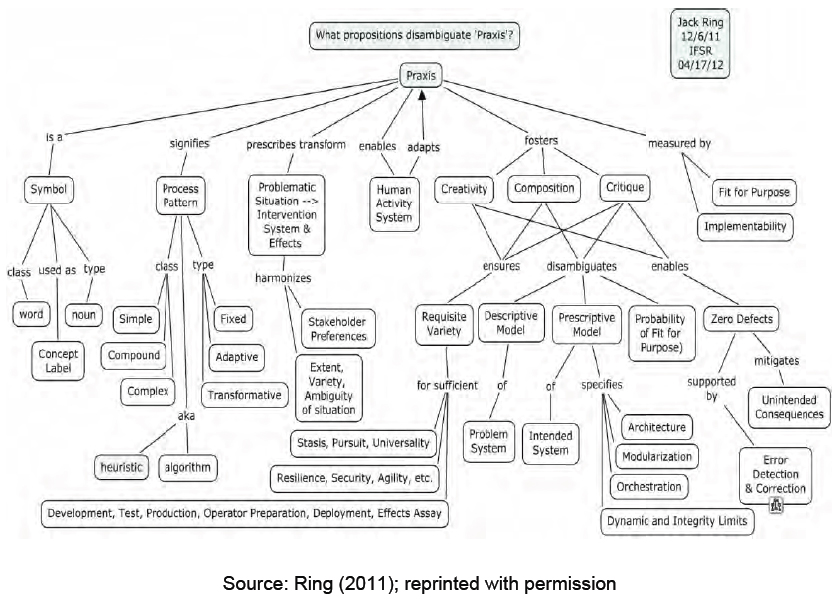
Systems Praxis concept map by Jack Ring. IFSR Conversations 2012
From literature searches, we found uses of “praxis” as “putting theories into action” or “theoryinformed practice”. We came up with working definitions of “systems praxis” as:
- Translating theory into action by thinking and acting in terms of systems.
- The act of engaging, applying, exercising, realizing, or practicing ideas about systems.
Systems praxis also includes the appreciation of systems by recognizing the quality, value, magnitude, or significance of, e.g., things or people as they contribute to system behaviors that lead to desirable outcomes.
2.4. Differences separating systems communities
We discussed at length the explicit and implicit differences that separated the various communities of systems theory and practice.
The IIGSS “Streams of Systemic Thought”4 diagram identifies lines of influence among those who have contributed to systems thinking from the early days of philosophy (e.g., Lao Tzu, Heraclitus, Plato, Aristotle) to more recent work (e.g., Peirce, von Bertalanffy, Ashby, Warfield). In addition to identifying lines of influence, the diagram is color-coded according to category of major work:
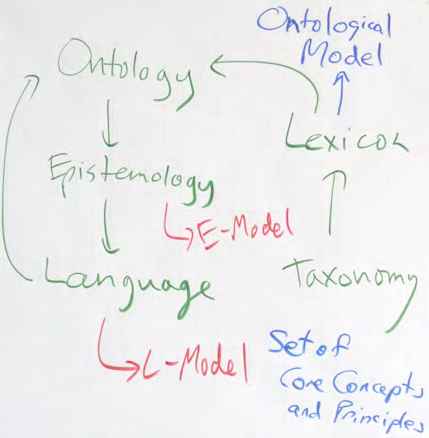
IIGSS Streams of Systemic Thought diagram. IFSR Conversations 2012
- General Systems
- Cybernetics
- Physical sciences
- Mathematics
- Computers & informatics
- Biology & medicine
- Symbolic systems
- Social systems
- Ecology
- Philosophy
- Systems analysis
- Engineering.
If integration between all these systems-related fields is possible, what would it require in terms of language, epistemology, ontology, culture, …?
We considered the “three cultures” of science, humanities, and design identified by Cross (1982):
In most cases, it is easier to contrast the sciences and the humanities (e.g., objectivity
versus subjectivity, experiment versus analogy) than it is to identify the relevant
comparable concepts in design. This is perhaps an indication of the paucity of our
language and concepts in the ‘third culture’, rather than any acknowledgement that it does
not really exist in its own right. But we are certainly faced with the problem of being more
articulate about what it means to be ‘designerly’ rather than to be ‘scientific’ or ‘artistic’.
Perhaps it would be better to regard the ‘third culture’ as technology, rather than design.
This ‘material culture’ of design is, after all, the culture of the technologist—of the
designer, doer and maker. Technology involves a synthesis of knowledge and skills from
both the sciences and the humanities, in the pursuit of practical tasks; it is not simply
‘applied science’, but ‘the application of scientific and other organised knowledge to
practical tasks…’5
According to Cross, the three cultures are distinguishable by how education in that culture entails ‘enculturation’ in the three aspects:
- transmission of knowledge about a phenomenon of study
- training in appropriate methods of enquiry
- initiation into the belief systems and values of the ‘culture’.
| Elements of the Three Cultures (after Cross,1982) | |||
| Culture | Phenomena | Methods | Values |
| Science | Natural world | • Controlled experiment • Classification • Analysis |
• Objectivity • Rationality • Neutrality • Concern for ‘truth’ |
| Design | Man-made world | • Modeling • Pattern-formation • Synthesis |
• Practicality • Ingenuity • Empathy • Concern for ‘appropriateness’ |
| Humanities | Human experience | • Analogy • Metaphor • Criticism • Evaluation |
• Subjectivity • Imagination • Commitment • Concern for ‘justice’ |

Relationships between Systems Science, Systems Engineering, & Systems Thinking. IFSR Conversations 2012
2.5. Relationships between Systems Science, Systems Engineering, & Systems Thinking
We discussed how the reality of systems praxis always contains some degree of each of our three main areas of focus: systems science (SS), systems thinking (ST), and systems engineering (SE). In the past, when 80% of systems engineering projects arguably involved few problem dimensions requiring systems science and systems thinking, it was possible to ignore the need to communicate with those other fields, let alone integrate them into a unified systems approach or systems praxis.
This no longer seems to be the case.
SE seeks solutions to the world’s problems but must consider the wide range of factors and scopes that this solution could entail. Hitchins (1993) describes the scope of a system as dependent on which layer it principally resides in: product, project, business, industry, or society. SE also needs to consider more than merely the technical aspects of a problem or solution, which can be represented by the PESTEL factors: Political, Economic, Social, Technological, Ecological, and Legal. This has been expanded by some to STEEPLED by adding
the factors of “Ethics” and “Demographics”.
Science seeks ‘truth’ whereas engineering is seeking solutions to the world’s problems using the truth found by science. As shown in 80 16th IFSR Conversation 2012 the figure at right, science seeks to understand and describe properties and relationships of things in the world while engineering strives to understand these properties and relationships in order to apply them to solutions to engineering problems. Engineering then will create new properties and relationships in their designed artifacts, properties including such things as behavior, functionality, performance, structure, economy, practicality, and so on.
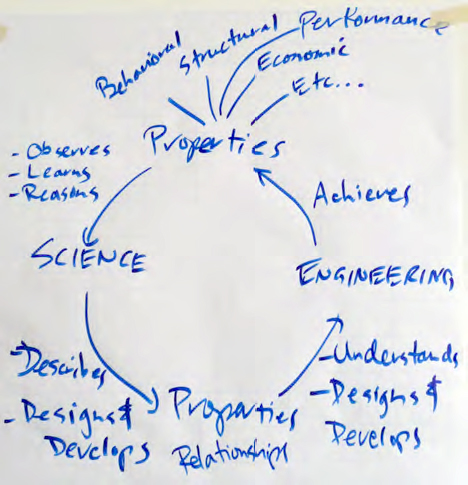
science and engineering system
coupling diagram. IFSR Conversations 2012
These complementary roles for science and engineering can also be seen in the system coupling diagram paradigm below. (Lawson, 2010)
A situation can be examined as a “system” (the so-called Situation System) and, from an understanding of this Situation System, a Respondent System can be devised that seeks to either exploit an opportunity identified therein or solve a problem caused by that situation. The Respondent System can be composed of system assets, either preexisting or needing to be designed and developed.6

Respondent System. Source: Lawson (2010); reprinted with permission. IFSR Conversations 2012
The systems coupling diagram is among the system concepts, principles and paradigms that Bud Lawson has successfully used for several years to convey the essence of systems thinking, change management and systems engineering to interdisciplinary course participants. These elements have contributed to “learning to think and act in terms of systems”—key components of systems praxis.
2.6. Systems praxis and Jack Ring’s “Value Cycle”
We also found that the concept of systems praxis was embodied in the Value Cycle developed by Jack Ring. The cycle starts with an understanding of value, i.e., what the community of stakeholders believes is important to them individually and collectively in the community situation. A problem is discerned from this focus on value and this can lead to an understanding of the “problem system”. The effect a solution might bring to bear on the problem is envisioned and an intervention strategy is devised. This strategy is translated into solution elements in the form of a problem suppression system (PSS). The specific attributes of the PSS are defined and the total solution is envisioned, architected, and designed. The PSS components are specified, developed, and assembled into the complete PSS, and finally tested to determine its fitness for purpose. The effect on operations is determined and these effects on the problem situation are noted, and then the cycle repeats.
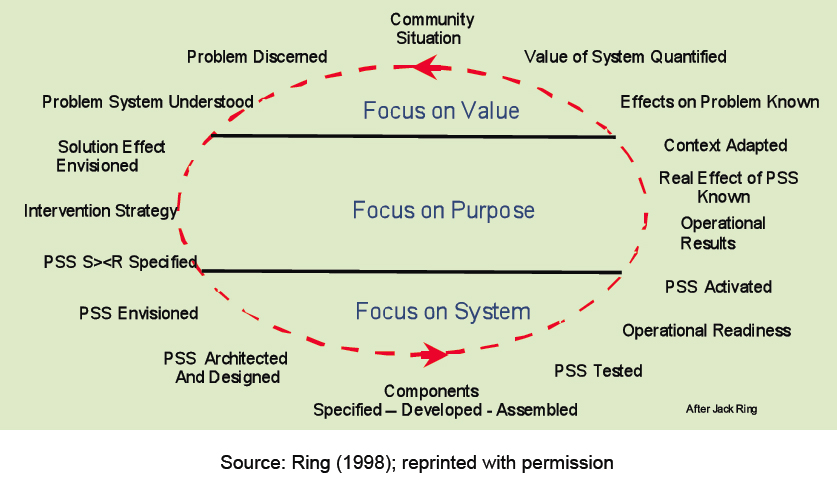
Value Cycle by Jack Ring. IFSR Conversations 2012
2.7. Key concepts that came up repeatedly in discussions
- Recursion
- Emergence
- Boundaries (especially purpose-dependent selection of boundaries), …
- Patterns and Affordances
- Dualities
- Hard/Soft
- Product/Process
- Holistic/Reductionist
- Positivist/Constructivist
- Subjective/Objective
- Potential/Actual
- Hierarchy/Holarchy.
3. CATWOE analysis for the “Common Language for Systems Praxis” project
On the fourth day, we used Checkland’s CATWOE7 approach (customers, actors, transformation, worldview, owners, environment) to synthesize our insights into an overview of the usage, context and constraints for any common language for systems praxis. (The elements are presented below in a “TACWOE” sequence since we found that order to be more helpful in developing understanding.)
- Transformation: We want practitioners to be able to use a “common language” (core concepts, principles, patterns, and paradigms) in an integrated systems approach in order to work with stakeholders to achieve a successful and sustainable transformation of a problem situation into an improved situation through an appropriate set of interventions.
- Actors/Stakeholders: Primary actors and stakeholders are those who work in the fields of Systems Science, Systems Thinking, and Systems Engineering, and the stakeholders who are critical to their success. Benefits: Practitioners, systems integrators, consultants, and their employers will find it easier and faster to work successfully across multiple communities of practice to achieve common purpose. Students will find it easier to integrate a systems perspective into their learning and discipline practice. Managers will have a reduction in their cognitive load due to reduced project complexity. And policy makers will benefit from clarity of exposition of complex systems issues.
- Customers: We think primary custo mers for this work are system practitioners, and possibly tool developers.
- Worldview: We want the “common language” to be useful to practitioners and other stakeholders concerned with problem situations that call for solutions involving hybrid systems including Social, Technical, Economic, Environmental, Political, Legal, Ethical, Demographic (STEEPLED) aspects.
- Owner(s): We want the common “language” to be adopted and owned by “The Systems Community” (practitioners, researchers, and educators). Initially it will be owned and curated on their behalf by the group that started this work at the IFSR workshop in Linz in 2012.
- Environmental Constraints: The language will be used by humans and machines accustomed to different languages, “symbol systems”, standards, and with different mental models, culture, experience, roles, seniority, status (power relationships), learning styles, neuro-linguistic programming (NLP) modalities, gender, education (scope, discipline, level), belief systems, and paradigmatic silos. Teams using the common language will be multidisciplinary; multi-site; multi-organizational; multi-national; suffering from spread-think and group-think; working under management pressure and complex legal, infrastructure, institutional constraints; sharing (or not) narratives and success stories, inertia, not-invented-here, collaborative/competitive behaviours. Systems Praxis will use knowledge from diverse disciplines, including Thermodynamics, Informatics, Biomatics, Teleonomics, Human Social Dynamics, Economics, Ecology, and many more. Systems developed will need to satisfy constraints from the natural environment (hazards, pollutants, resources); social environment (social requirement, public acceptance, increase in population); and engineering and design environment (laws, specifications, codes, new built & maintenance, intended lifetime, transition strategies, …).
4. Developing a summary “systems praxis” diagram
With our CATWOE checklist as context, we turned to producing a summary diagram to capture insights we had gained into what might be involved in unifying systems praxis across ‘tribes’. We started from a preliminary version of the diagram below, which proposed an “Integrated Systems Approach” that incorporated 1) systems thinking for “understanding systems in a human context”; 2) systems science for the “theory of systems”; and 3) systems engineering for “making choices about how to create and adjust a new system or modify an existing one to better achieve a purpose”. 8
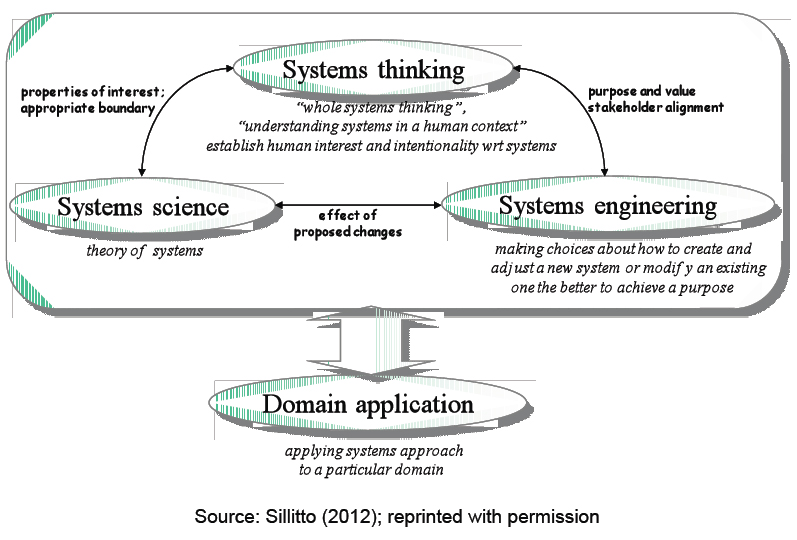
Applying a Systems Approach to a particular domain. IFSR Conversations 2012
We made a number of attempts to combine the above diagram with insights from the week’s conversation into a single framework, including, e.g., core systems concepts, principles, and patterns; the nature of systems praxis; the “three cultures”; the breadth of existing systems fields; and thinking and acting in terms of systems. At this point, we did not expect to be able to identify the specific attributes of common language that could be shared between SS, ST, and SE in an integrated systems approach. We wanted, at a minimum, to identify the outlines of a vision of systems praxis that could provide foundation and context for future work on questions of common language, ontology, etc.
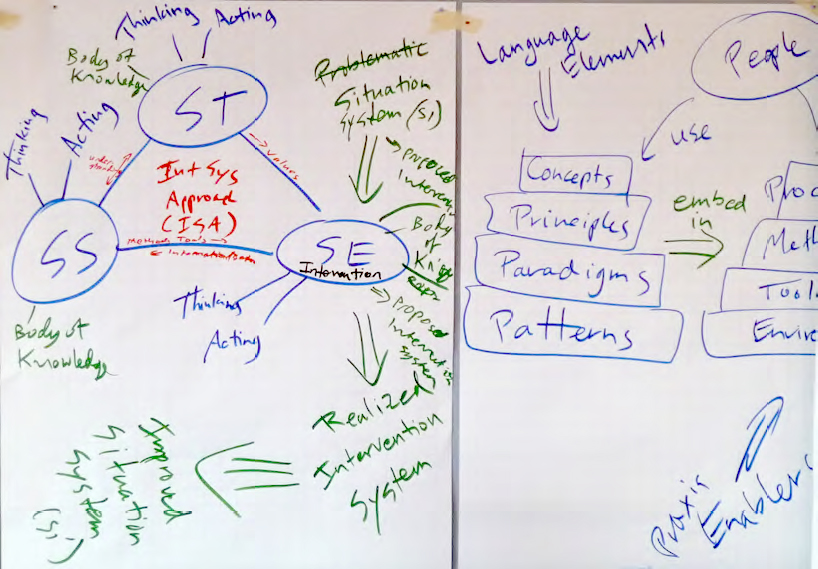
Single framework for three cultures. IFSR Conversations 2012
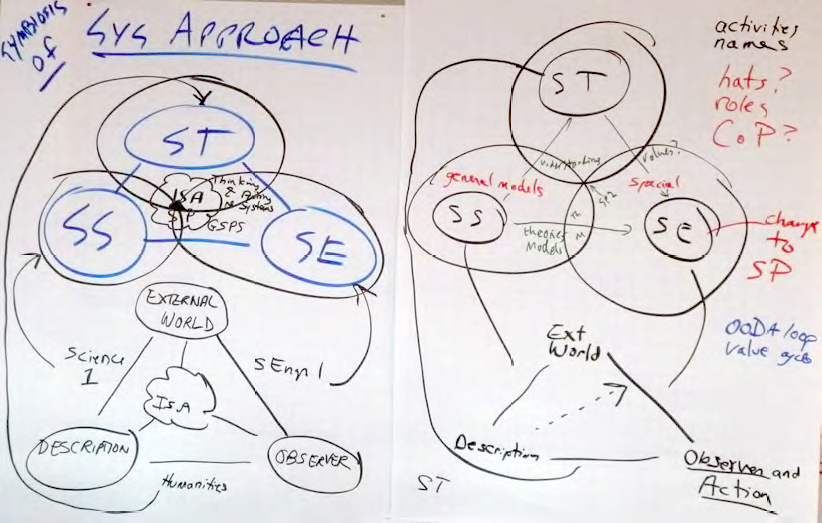
Single framework for three cultures, V2. IFSR Conversations 2012
When we took the step of adding a top-level category for social-systems-oriented “Systems Intervention” (SI in our diagram) to cover systems approaches to practice outside of Systems Engineering, we started to find useful dimensions and symmetries that illuminated the relationships we were interested in. These allowed us to develop a diagram showing how a “Unified Systems Praxis” could put theories from Systems Science and Systems Thinking into action through the approaches of technically-oriented Systems Engineering and socially-oriented Systems Intervention.
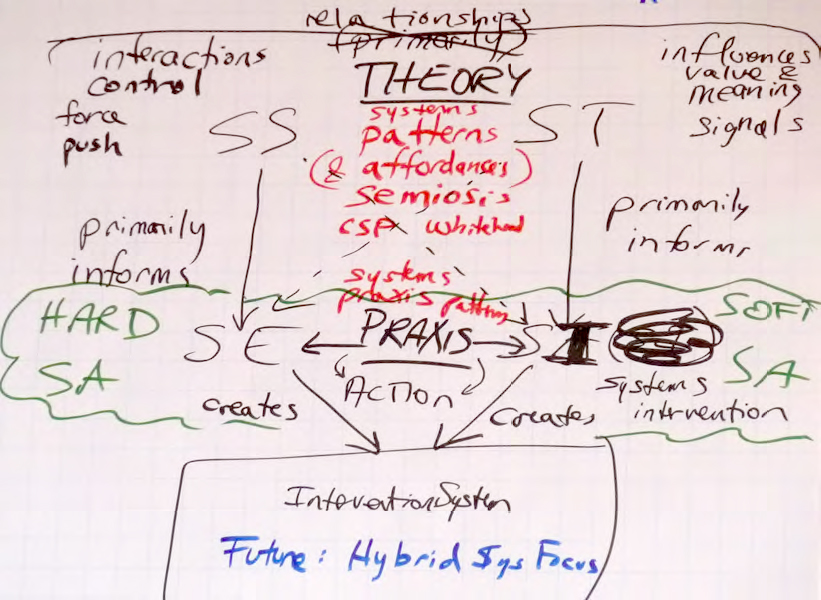
Single framework for three cultures, V3. IFSR Conversations 2012
The culmination of the week’s effort is below. This diagram depicts Systems Praxis in terms of a cycle between Theory and Action, where Systems Science and Systems Thinking sources of theory feed into a “cloud” spanning System Engineering and Systems Intervention sources of action. Quantitative and qualitative evaluations of the outcomes from interventions feed back into the cloud. A continuum of systems approaches ranges from “Hard” (emphasizing control and performance, and tending toward quantitative and analytic methods) to “Soft” (emphasizing influence and values, and tending toward narrative and experiential methods). We did not reach a definitive conclusion regarding how to relate the Hard-Soft continuum to Systems Science and Systems Thinking. We did discuss how future systems praxis integration efforts—including work on common language, core concepts, etc.—could relate Systems Science and Systems Thinking via systems patterns, and Systems Engineering and Systems Intervention via praxis patterns.

Systems Science and Systems Thinking via systems patterns, and Systems
Engineering and Systems Intervention via praxis patterns. IFSR Conversations 2012
We learned that the best medium for communication across different tribes is patterns, and that a common language for Unified Systems Praxis could use system patterns and praxis patterns to relate core concepts and principles across paradigms, allowing stakeholder silos to more effectively work together. By using a neutral language and not “boxing in” the domains, we were able to “separate the people from the problem.” The result was a step towards a common map that each tribe could use to explain its own narrative, worldview, and belief system, as well as to appreciate how the various worldviews and belief systems complement and reinforce each other within systems praxis.
Following the conclusion of the IFSR Conversation, some team members continued developing the above diagram to resolve issues that had not been fully addressed during the week and to further realize the integrative potential revealed in the original. The resulting Systems Praxis Framework, which is presented as an addendum to this report, will be in the INCOSE Guide to the Systems Engineering Body of Knowledge (SEBoK) at http://www.sebokwiki.org/1.0/index.php/Systems.
References (for the week)
Checkland, P. (1983). O.R. and the systems movement: Mappings and conflicts. Journal of the Operational Research Society, 34(8), 661–675.
Checkland, P. (1985) Achieving ’desirable and feasible’ change: An application of soft systems methodology. Journal of the Operational Research Society, 36(9), 821–831.
Cross, N. (1982). Designerly ways of knowing. Design studies, 3, 221-227.
Henshaw, M., Lister, P., Park, E., Ilminster, S., Harding, A., Kemp, D., et al. (2011). Capability engineering—an analysis of perspectives. In Proceedings of the 21st Annual International Symposium of the International Council of Systems Engineering.
Hitchins, D. (1993). Putting systems to work. John Wiley & Sons, Inc.
Hybertson, D.W. (2009). Model-oriented systems engineering science: a unifying framework for traditional and complex systems. Auerbach Publications.
Ing, D. (January, 2012). Science, systems thinking, and advances in theories, methods and practices. Available from http://coevolving.com/blogs/index.php/archive/science-systems-thinking-and-advances-in-theoriesmethods-and-practices
International Institute for Global Systems Studies. (2001). Some Streams of Systemic Thought, originated in 1996 by Dr. Eric Schwarz, Neuchâtel, Switzerland. Available from http://www.iigss.net/files/gPICT.pdf
Kast, F., & Rosenzweig, J. (1972). General system theory: Applications for organization and management. Academy of Management Journal, 15(4), 447–465.
Lawson, H.W. (2010). A journey through the systems landscape. College Publications.
Metcalf, G., Ring, J., Hybertson, D., Lawson, H.W., Wilby, J., Troncale, L., et al. (2011). Systems science and systems engineering white paper. Available from http://bit.ly/St00FI
Praxis (process). In Wikipedia. Retrieved February 8, 2012, from http://en.wikipedia.org/wiki/Praxis_(process).
Ring, J. (1998) Engineering Value-seeking Systems, IEEE-SMC Conference Proceedings.
Sheard, S. (1996). Twelve systems engineering roles. In Proceedings of the 6th Annual International Symposium of the International Council of Systems Engineering.
Sillitto, H. (2009). On systems architects and systems architecting: some thoughts on explaining and improving the art and science of systems architecting. In Proceedings of the 19th Annual International Symposium of the International Council of Systems Engineering.
Sillitto, H. (2010). Design principles for ultra-large-scale (ULS) systems. In Proceedings of the 20th Annual International Symposium of the International Council of Systems Engineering.
Sillitto, H. (2012). “Integrating Systems Science, Systems Thinking and Systems Engineering: understanding the differences and exploiting the synergies”. INCOSE International Symposium, Rome. (Draft)
Sowa, J. (2001). Signs, processes, and language games–foundations for ontology. In Proceedings of the 9th International Conference On Conceptual Structures. Available from http://www.jfsowa.com/pubs/signproc.htm
Sowa, J. (2006). The challenge of knowledge soup. Research Trends in Science, Technology and Mathematics Education, 55–90. Available from http://www.jfsowa.com/pubs/challenge
Troncale, L. (2006). Towards a science of systems. Systems Research and Behavioral Science, 23(3), 301–321.
Von Bertalanffy, L. (1972). The history and status of general systems theory. Academy of Management Journal, 15(4), 407–426.
Wilkinson, M., King, P., James, A., Emes, M., & Bryant, P. (2010). Belief systems in systems architecting: method and preliminary applications. In 5th International Conference on System of Systems Engineering.
Yearworth, M. (2010). Thinking about systems thinking. (Unpublished)
Yearworth, M. (2012). Systems practice in engineering. Available from http://www.slideshare.net/mikeyearworth/my-130710
Addenda (following in this volume)
The Systems Praxis Framework
D. Hybertson: Comparison of Team 4 position paper themes and concepts
H. Lawson: Systems paradigms and praxis
J. Martin: Four thought patterns in support of the systems approach
R. Martin: Obstacles to a unified systems praxis ontology
J. Singer: An empirical taxonomy of modeling approaches (excerpt)
Supplement materials available at http://ifsr.ocg.at/world/files/$12f$Magdalena-2012-supp.pdf
Notes from the Team 4 Conversation: Towards A Common Language for Systems Praxis
H. Lawson: Paradigms to Promote Thinking and Acting in Terms of Systems
H. Sillitto: Integrating Systems Thinking, Systems Science and Systems Engineering
T. Tatsumasa: Experienced Theory and Praxis of Human Activity
T. Tatsumasa: Common Languages: Natural Languages and Invented Languages
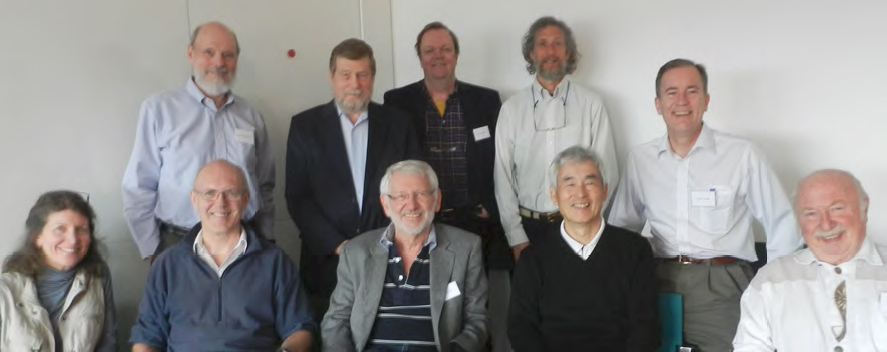
Team 4 Group Photo, IFSR Conversations 2012
Footnotes
1 Preliminary Systems Science Working Group material on this topic is available at http://sites.google.com/site/syssciwg/meetings/workshop-2012-january
2 See D. Hybertson’s “Comparison of Team 4 position paper themes and concepts” in the Addenda to this report.
3 See R. Martin “Obstacles to a unified praxis ontology” in the Addenda to this report.
4 International Institute for Global Systems Studies (2001). See http://www.iigss.net/files gPICT.pdf.
5 Cross, 1982. pp. 221-223
6 See B. Lawson’s “Paradigms to promote thinking and acting in terms of systems” available in http://ifsr.ocg.at/world/files/$12f$Magdalena-2012-supp.pdf
7 Checkland (1985). See also http://en.wikipedia.org/wiki/Soft_systems_methodology#CATWOE
8 See H. Sillitto’s “Integrating Systems Thinking, Systems Science and Systems Engineering” available in http://ifsr.ocg.at/world/files/$12f$Magdalena-2012-supp.pdf
